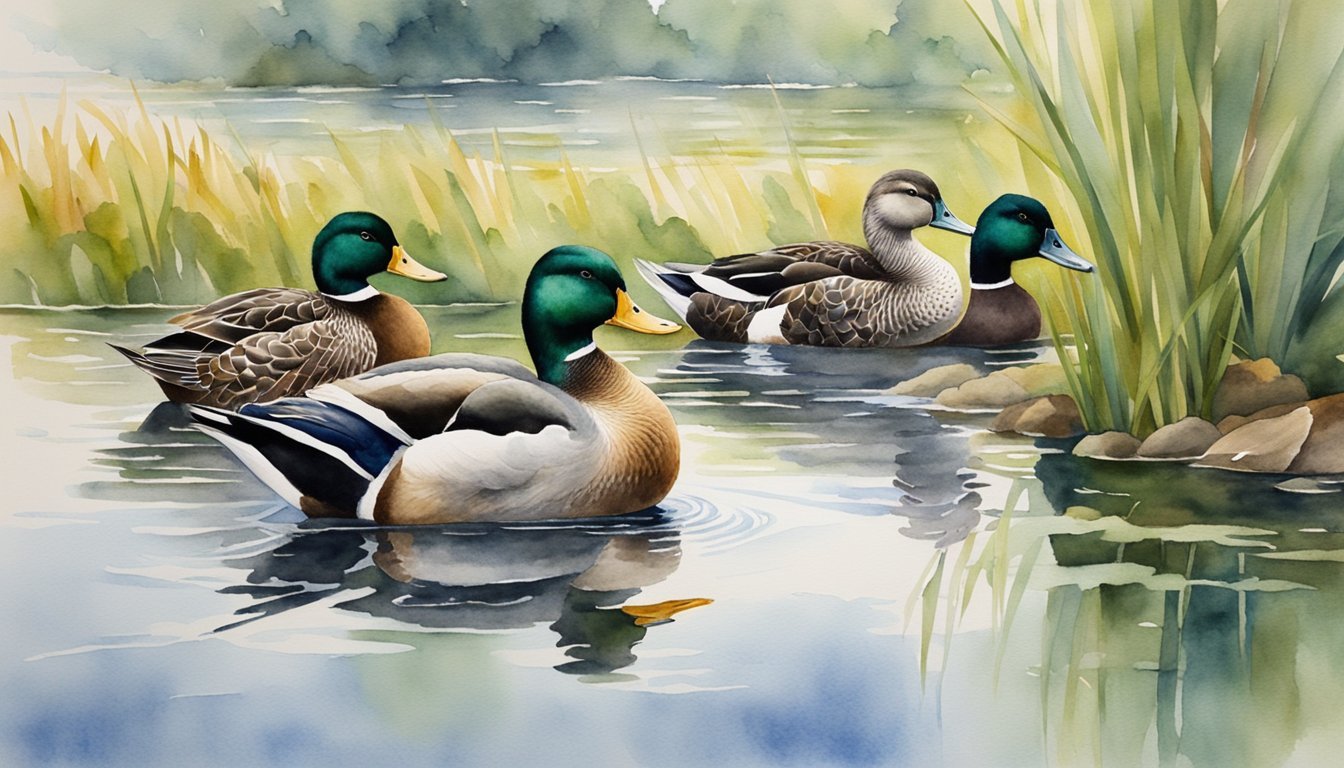Duck Basics
In exploring duck basics, it’s essential to understand their distinct anatomy and the varied habitats they inhabit. These birds are known for their unique feathers and efficient bill structure that contribute to their survival and propagation.
Anatomy and Appearance
Ducks are a diverse group of waterfowl with distinct features that set them apart from other bird species. They have a broad bill used for foraging, waterproof feathers that keep them buoyant, and webbed legs designed for swimming. The wing structure of ducks is relatively strong, enabling some species like the Mallard and Wood Duck to migrate long distances. Ducks generally exhibit sexual dimorphism, meaning that males and females can look significantly different; for instance, the male Mallard is known for its vibrant green head, while the female displays a muted brown plumage.
- Bill: Flat and broad, suitable for dabbling in water.
- Feathers: Waterproof and aid in buoyancy.
- Legs: Webbed legs for efficient swimming.
Examples of duck species include the colorful Wood Duck, the sociable Mallard, the diving Canvasback, and the compact Bufflehead. Each species has a tail structure that aids in flight maneuverability and balance.
Habitat and Distribution
Ducks are found in a wide range of habitats across the world, from freshwater lakes and marshes to coastal shores and estuaries. Adaptations like their feathers and webbed feet make them proficient in both water and air, which aids these birds in finding suitable habitats. Ducks can be broadly categorized into dabblers, like the Mallard, which feed on the water surface, and divers, like the Canvasback and Bufflehead, which submerge to forage for food.
Habitat specifics for varied species:
- Mallard: Prefers wetlands, ponds, and rivers.
- Wood Duck: Inhabits wooded swamps and streams.
- Canvasback: Often found in larger deep water bodies.
- Bufflehead: Frequents sheltered coastal waters.
The global distribution of ducks makes them a common sight in various environments. Many species, like the Mallard, are adaptable and can thrive in urban parks as well as wild areas, demonstrating their versatility within their respective habitats and distribution.
Duck Behavior and Ecology

Ducks exhibit a diverse range of behaviors and ecological adaptations, crucial for their survival and reproduction. From their unique foraging techniques to the intricate process of nesting and raising ducklings, understanding these aspects is vital for both wild and domestic duck species.
Feeding and Diet
Ducks are omnivorous birds, and their diet consists of aquatic plants, fish, and insects. Dabbling ducks forage for food near the water’s surface, tipping forward to graze on underwater plants. In contrast, diving ducks plunge deep underwater to catch fish. The availability of food resources greatly influences their habitat preferences, which include lakes, ponds, and rivers. Learn more about duck behaviors including their foraging habits.
Reproduction and Lifecycle
The lifecycle of ducks begins with the mating season, where males display vibrant plumage to attract females. Once a mate is selected, hens lay their eggs in nests concealed in dense vegetation to protect from predators. The drake plays no part in incubating the eggs or raising the ducklings. The hen’s dedication ensures that a high percentage of eggs successfully hatch. After hatching, ducklings quickly adapt to the water and begin foraging for themselves under the watchful eye of their mother. Duck nesting ecology is a complex process shaped by evolution and natural selection.
Conservation and Human Interaction
Duck populations are affected by habitat loss, hunting, and environmental changes. Conservation efforts focus on preserving wetlands—their primary breeding grounds—and protecting migratory routes. Human interaction with ducks varies from region to region, with some societies practicing sustainable hunting while others engage in domestication for agricultural purposes. However, the balance between use and conservation is crucial to maintain stable duck populations and ecosystems. Discover insights on brood ecology and conservation measures crucial for duckling survival.

